William Beckwith McInnes
William Beckwith McInnes (18 May 1889 – 9 November 1939) was an Australian portrait painter, winner of the Archibald Prize seven times for his traditional style paintings. He was an instructor and acting-director at the National Gallery of Victoria
William Beckwith McInnes | |
|---|---|
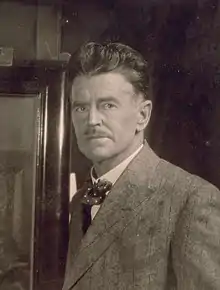 | |
| Born | 18 May 1889 |
| Died | 9 November 1939 (aged 50) |
| Nationality | Australian |
| Known for | portraits |
| Spouse(s) | Violet Murial Musgrave (1915-39) |
| Awards | Archibald Prize, 7 times between 1921–1939; Wynne Prize (1921) |
Early life
McInnes was born in St Kilda, a suburb of Melbourne, to Malcolm McInnes and his wife Alice Agnes, née Beckwith. Despite lack of family artistic tradition, he was keen to draw from the time he could hold a pencil. In 1903, at 14 years of age, he enrolled in the drawing school of the National Gallery of Victoria under Frederick McCubbin. Later he moved up to the painting school under Lindsay Bernard Hall.
Artistic career
He won his first prizes for drawing the figure from life, and for painting a head from life, and shared the prize for a landscape in 1908.
Soon afterwards McInnes held a successful show of his paintings at the Melbourne Athenaeum Gallery in conjunction with F. R. Crozier, which was followed in 1911 by a journey to Europe where he did much landscape painting and made acquaintance with the masterpieces of Rembrandt, Velasquez and Raeburn.
McInnes was represented in London at the exhibition of the Royal Institute of Painters in oils in 1913.[1]
He returned to Melbourne in the same year, where a one-man show was held at the Athenaeum gallery and nearly everything was sold. In 1916 he acted as locum tenens for Frederick McCubbin, master of the school of drawing at the National Gallery of Victoria, during McCubbin's six months' leave of absence. McInnes was temporarily appointed to the position in 1918 after McCubbin's death, and in 1920 he was permanently appointed.
In 1921, he won the first Archibald Prizes for portraiture. He went on to win the award a total of seven times.[2]
McInnes revisited Europe in 1925 and found he was in great demand as a portrait painter. For many years he was unable to spare time to do landscape work. In 1927 he was commissioned by the Federal government to depict the opening of the first parliament in Canberra by the Duke of York.[3] [4] In 1928 he exhibited with the Royal Academy, and in 1933 he visited England again to paint the Duke of York (later King George VI).
In the following year when Bernard Hall left for England as adviser for the Felton bequest, McInnes was appointed acting-director of the National Gallery of Victoria, and on Hall's death, was appointed head of the painting school.[5]
Amongst the many portraits by McInnes were those of the surgeons Archibald Watson and Wood Jones.
McInnes' artwork is featured at the Art Gallery of South Australia and the Art Gallery of NSW. In addition, McInnes has painted a variety of important people in Australian history including officials and aristocratic families.
Late life
McInnes suffered from an imperfect heart all his life. On 30 November 1937 around midnight the car he was driving struck and killed a pedestrian on Brunswick Street, Fitzroy. At the inquest evidence was brought forward that a drug (Luminal) he was taking for the condition could have affected his driving and been responsible for his staggering and not remembering details of the accident.[6] He was not convicted of any offence.
His general health became affected and in July 1939 he resigned his position as master of the National Gallery art school.[7] He died on 9 November 1939.[8] He married Violet Muriel Musgrave in 1915, a capable flower painter, who survived him with four sons and two daughters.
McInnes' Archibald Prize winners
- 1921 - Desbrowe Annear[9]
- 1922 - Professor Harrison Moore[10]
- 1923 - Portrait of a Lady[11]
- 1924 - Miss Collins[12]
- 1926 - Silk and Lace (Miss Esther Paterson)[13]
- 1930 - Drum-Major Harry McClelland[14]
- 1936 - Dr. Julian Smith[15]
.jpg.webp) 1921
1921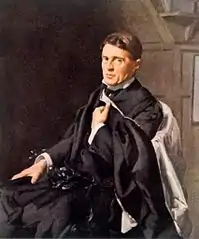 1922
1922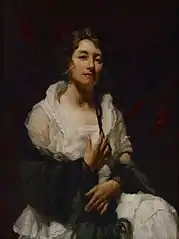 1923
1923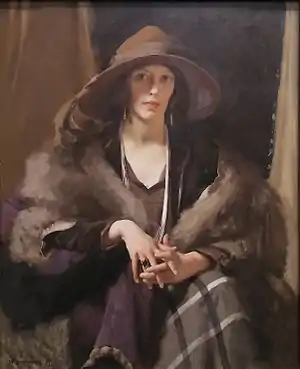 1924
1924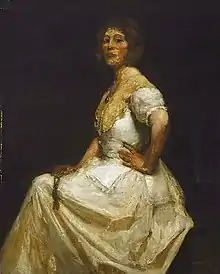 1926
1926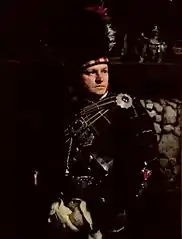 1930
1930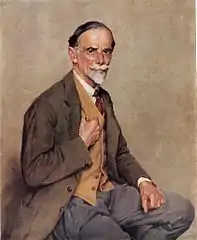 1936
1936
McInnes also won the Wynne Prize in 1918 with The Grey Road.
References
- "Royal Institute Of Oil Painters". The Times: 10. 3 October 1913 – via The Times Digital Archive.
- Haese, Richard, "McInnes, William Beckwith (Billy) (1889–1939)", Australian Dictionary of Biography, National Centre of Biography, Australian National University, retrieved 25 January 2019
- Haese, Richard, "McInnes, William Beckwith (Billy) (1889–1939)", Australian Dictionary of Biography, National Centre of Biography, Australian National University, retrieved 19 March 2019
- "William Beckwith McInnes painting the opening of the first Commonwealth Parliament, Canberra, ca. 1927 [picture]". nla.gov.au. Retrieved 19 March 2019.
- Findlay, Elisabeth (1 January 1992). "The Liberal Teaching Philosophies of William Dargie: The National Gallery School from 1946 to 1953". Australian Journal of Art. 10 (1): 66–79. doi:10.1080/03146464.1992.11432810. ISSN 0314-6464.
- "Open Verdict". Newcastle Morning Herald and Miners' Advocate (19, 090). New South Wales, Australia. 18 December 1937. p. 11. Retrieved 5 December 2019 – via National Library of Australia.
- "Personal". The West Australian. 55 (16, 545). Western Australia. 13 July 1939. p. 16. Retrieved 5 December 2019 – via National Library of Australia.
- "Family Notices". The Argus (Melbourne) (29, 085). Victoria, Australia. 10 November 1939. p. 4. Retrieved 5 December 2019 – via National Library of Australia.
- Winner: Archibald Prize 1921, Art Gallery of NSW.
(AGNSW Collection entry) - Winner: Archibald Prize 1922, Art Gallery of NSW
- Winner: Archibald Prize 1923, Art Gallery of NSW.
(AGNSW Collection entry) - Winner: Archibald Prize 1924, Art Gallery of NSW
Miss Gladys Neville Collins (1891–1960) was the daughter of J.T. Collins, lawyer, Victorian State Parliamentary draughtsman, and trustee of the Public Library, Museums and National Gallery of Victoria.
She was also painted and drawn by George W Lambert:
- The white glove 1921, Lambert Retrospective, nga.gov.au;
- Head study of Miss Gladys Neville Collins 1922, George W. Lambert, National Gallery of Victoria, Melbourne.
- Winner: Archibald Prize 1926, Art Gallery of NSW.
(AGNSW Collection entry) - Winner: Archibald Prize 1930, Art Gallery of NSW
Harry McClelland (1884–1954) was an artist and philanthropist living south of Melbourne with a hobby as a pipe band leader. McClelland Sculpture Park and Gallery, mcclellandgallery.com;
Fiona Gruber (14 December 2012). "Dame's grand vision pays off". The Sydner Morning Herald.;
"Philanthropy and Art at Bolinda". Flemington Heritage. - Winner: Archibald Prize 1936, Art Gallery of NSW
Dr Julian Augustus Smith (1873–1947) was a surgeon and photographer.
K. F. Russell. Smith, Julian Augustus (1873–1947). Australian Dictionary of Biography. Australian National University. First published in Australian Dictionary of Biography, Volume 11, (MUP), 1988.
Sources
- Haese, Richard. "McInnes, William Beckwith (Billy) (1889–1939)". McInnes, William Beckwith (1889 - 1939). Australian Dictionary of Biography. MUP. Retrieved 15 July 2007.
- Serle, Percival (1949). "McInnes, William Beckwith". Dictionary of Australian Biography. Sydney: Angus and Robertson.
External links
| Wikimedia Commons has media related to William Beckwith McInnes. |
| Awards and achievements | ||
|---|---|---|
| Preceded by new award |
Archibald Prize 1921 for Desbrowe Annear 1922 for Professor Harrison Moore 1923 for Portrait of a Lady 1924 for Portrait of Miss Collins |
Succeeded by John Longstaff |
| Preceded by John Longstaff |
Archibald Prize 1926 for Silk and Lace |
Succeeded by George Washington Lambert |
| Preceded by John Longstaff |
Archibald Prize 1930 for Drum-Major Harry McClelland |
Succeeded by John Longstaff |
| Preceded by John Longstaff |
Archibald Prize 1936 for Dr. Julian Smith |
Succeeded by Normand Baker |